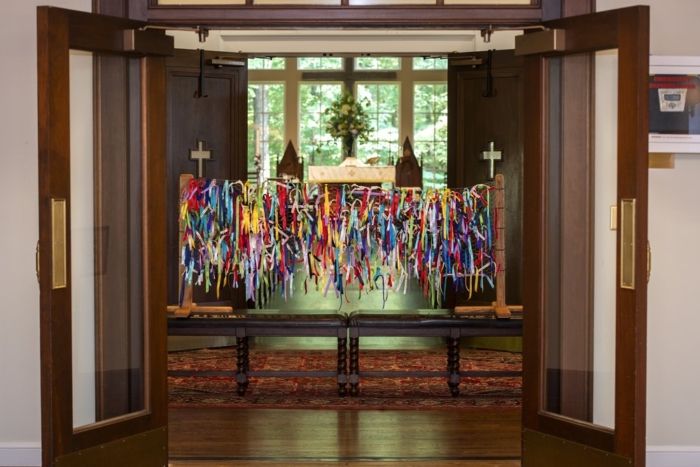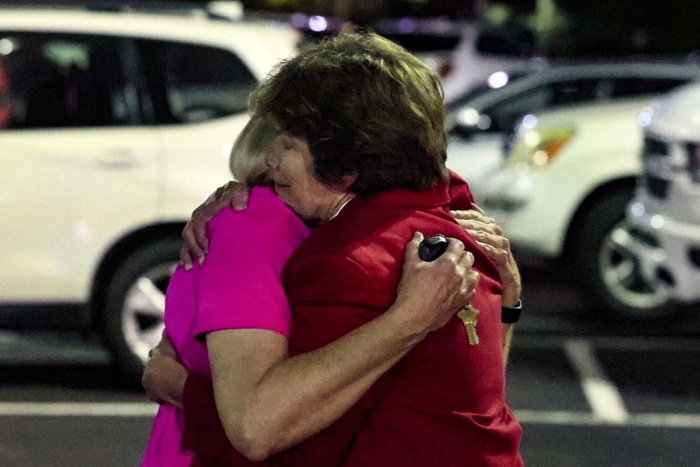Five months after three members died in shooting, Alabama church processes grief and rediscovers joyPosted Nov 7, 2022 |
|

Ribbons with prayers and messages of support at St. Stephen’s Episcopal Church in Vestavia Hills, Alabama. Photo source: St. Stephen’s Episcopal Church
[Episcopal News Service] On June 16, St. Stephen’s Episcopal Church in Vestavia Hills, Alabama, lost three parishioners in a deadly shooting that brought the American gun violence epidemic to the parish hall.
“We have been confronted with the question of, what does our faith mean to us? What is the Gospel? What does it mean to love and to give of ourselves?” the Rev. John Burruss told Episcopal News Service. “And I believe that people have a deeper understanding – I certainly do – that God is with us through the midst of joy and sadness and pain.”
In the five months since an occasional churchgoer killed longtime parishioners Bart Rainey, 84, Sharon Yeager, 75, and Jane Pounds, 84, at a potluck, the parish has emerged into a space where pain and healing coexist. As the parish processes the grief together, a new kind of shared faith has emerged, Burruss said.
Attendance at St. Stephen’s has returned to pre-pandemic levels and 28 adults were confirmed on Nov. 6, creating “a sense of vibrancy and commitment that is incredibly beautiful,” he said.
Through healing from the trauma of June 16 and honoring the memory of Rainey, Yeager and Pounds, parishioners’ bonds have strengthened and they are beginning to create something new. Bart’s daughter Melinda Rainey Thompson, an author and creative writing professor at Birmingham-Southern College, has been leading parishioners in processing the trauma of that day through writing. Burruss thinks the project might “morph into something different that is just a life-giving creative outlet for people’s talent, and a way of trying to offer something new into this world.”
One of the most significant tasks in the healing process, Burruss said, was reclaiming the physical space where the shooting happened. On July 7, three weeks after the shooting, the survivors of the shooting gathered in the parish hall for a Eucharist and healing prayer before having dinner elsewhere with a larger group, “just laughing and just being together in this beautiful, sacred moment.”
Three days later, the whole congregation was invited for a special liturgy with Alabama Bishop Glenda Curry on July 10, celebrating the Liturgy of the Word in the sanctuary and then processing down to the parish hall for the Eucharist.

The three victims of the shooting at St. Stephen’s Episcopal Church: Bart Rainey, Jane Pounds and Sharon Yeager.
The survivors of the shooting and other congregants have had group counseling sessions, which are covered by the parish’s insurance policy, Burruss said. The parish has also invited speakers with trauma expertise or experience, such as the Rev. Sam Wells, vicar of St. Martin-in-the-Fields and visiting professor of Christian ethics at Kings College both in London, England. Wells had given a talk about healing in the parish hall in February 2022, about four months before the shooting. He returned four months after the shooting, in the same space, to talk about the same subject in a different context, giving a lecture titled “The Hurt and the Damage: Letting Horror Turn into Wisdom.”
The Rev. David Peters, a church planter from Pflugerville, Texas, visited in August to give a workshop and sermon on “the post-traumatic Jesus,” a subject he has written a book about. Peters developed symptoms of post-traumatic stress disorder after serving as a chaplain during the Iraq War and has counseled individuals and congregations on healing from violent trauma.
“[The Book of] Ecclesiastes does a good job of this,” Burruss told ENS. “You get the joy, but you get the joy on the other side of the realness of life. It doesn’t mean we’re not sad. It doesn’t mean there’s not the real effects of PTSD. When Jesus returns, in the resurrected form, there’s wounds in his hands, and yet that’s a sign of hope and witness.”
The shooting also put St. Stephen’s in the company of other Episcopal parishes that have firsthand experience with gun violence. The Very Rev. Kathie Adams-Shepherd, who was the rector of Trinity Episcopal Church in Newtown, Connecticut, at the time of the 2012 Sandy Hook Elementary School shooting, wrote a letter to the parish community; in it, she noted that after the massacre, her parish experienced “a much larger community of God’s love and light than we ever imagined.” St. Philip’s Episcopal Church in Uvalde, Texas, where 19 children and two adults were killed in a school shooting in May, sent St. Stephen’s a shipment of tissues.
Burruss told ENS he doesn’t have any new information about the shooter’s motives beyond what was known at the time of the shooting. Seventy-year-old Robert F. Smith had attended various parish events for a few months but wasn’t well known to parishioners or clergy.

People console each other after the shooting at St. Stephen’s Episcopal Church on June 16. Photo: Butch Dill/AP
“We saw glimmers of hope and a desire to be a part of the community. And we recognized some pain there,” Burruss said.
The sadness of June 16 is still visible in a stone inlay being added to the church’s outdoor labyrinth as a memorial to Rainey, Yeager, Pounds and other victims of gun violence. And construction is underway on the church’s memorial garden – planned since before the shooting – where Pounds is interred.
Yet the church campus is as lively as ever, Burruss said. In the weeks after the shooting, people were invited to write prayers on brightly colored ribbons and tie them on wire in front of the altar, and a group of artists is making those ribbons into an altar frontal and perhaps a banner or two. When the church hosted a Halloween celebration, “this campus was just bustling with costumes and games,” Burruss said. “That is a part of the story; it’s still a vibrant and joyful place.”
Burruss is heartened by the increased involvement in parish life that he’s seen since the shooting, especially from those who witnessed it.
“I think most everybody who was there that night is as involved as they were before or more involved – people are finding ways of being plugged in and committed to their community,” he said. “People show up and walk with each other and look for meaningful ways of not only carrying on their faith, but carrying on the faith of those that we’ve lost.”
Correction: An earlier version of this story misstated the number of people who were confirmed on Nov. 6.
– Egan Millard is an assistant editor and reporter for Episcopal News Service. He can be reached at emillard@episcopalchurch.org.

Social Menu